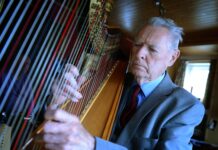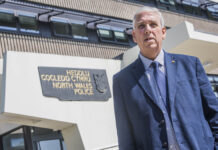THEY are both married in real-life though there is no room for domestic bliss thanks to the predicament Emily Blunt and John Krasinski find themselves in in the US box-office smash A Quiet Place, an often genuinely scary horror which benefits from a direction courtesy of Krasinski.
In what appears to be a post-apocalyptic world, a family struggle to live in a society that has been ravaged by demonic creatures who attack their prey upon hearing the faintest of noise.
As a result, husband Lee, wife Evelyn, their deaf daughter Regan and their two sons Beau and Marcus are forced to live in total silence, communicating via sign-language and attempting to avoid any form of noise occurring.
We get an idea of how long-lasting the problem has been with a title card upon opening simply stating DAY 89. During their perilous trek collecting supplies from an abandoned town to their home in the woodlands, the trip is beset by a tragic occurrence which highlight the struggles the family face in their bid for survival.
Fast-forward to DAY 482 and the family continue to maintain this existence, with Lee’s basement turned into an area of research about the creature and Evelyn pregnant with another child, despite the added risks.
Although the parents stay strong for the sake of the children, that does not prevent events which build-up to an inevitable showdown with the lives of our human heroes at stake.
There is lot of good to say about this work with reference to being a horror film, in spite of the imperfections that prevent it from being a modern horror classic.
Beginning with a wholly intense opening-sequence, Krasinski is successful at creating a mood that lingers throughout, combining the notion of innocence with the emphasis on danger. Such is the impact that the closing of this sequence has that one believes the film peaks too early on, but the use of horror is effective enough at times to keep us believing in the story.
The director employs a soundtrack which to say is spine-tingling would be seen as citing an overused expression, but as far as contemporary horror goes, one cannot help but refer to that given its status as genuinely frightening.
Another element of the film’s success is the use of silence which stays that way for the vast majority of the film, fitting its way cleverly into the story and providing the film with more success at crafting fear for the viewer where something seemingly innocent occurs. That is illustrated on several occasions, notably when a character drops a toy early on during the trip outside, only for it to be caught at the last possible moment, a particularly useful example of mise-en-scene which pops up often.
By noticing the significance of scenes where silence is imperative, the film makes one wonder how the film is going to play with reference to Evelyn’s pregnancy. The situation is obviously bad enough, so having a heavy pregnancy added in does provide questions which help build upon the family’s predicament and in doing so, shift the interest in the narrative.
Made more impressive is the fact this this is Krasinski’s first horror having only previously directed two comedy-dramas and even if this turns out to be his sole effort in this genre, it has certainly left a mark.
The film’s method of focusing entirely on the family with barely anyone involved shows that it has to count on its performers in their respective roles of protectors and protected. There are scenes when it does as best it can and it takes some getting used to before we can settle knowing its limited use of character will likely remain.
Blunt is very competent in the role of a woman left with having to focus not just on protecting those around her, but preparing to bring a child into a world that is not even that. Reaction is central to her performances this and proves her worth as a lead actress as capable of playing vulnerable as she is playing strong.
Krasinski also delivers a respectable performance alongside his directorial efforts as the chief protector whose struggles to provide the best for his family are clearly depicted. In one of the few sequences that involve dialogue, Lee is shown taking his son to a river which is the only place where they can verbally communicate due to their voices being drowned out and away from the creatures’ reach, despite the son’s initial fears.
There are some minor flaws, but the overall result with A Quiet Place is that John Krasinski can helm a horror with success thanks to its effective and distinctive use of location, soundtrack and storytelling.



























